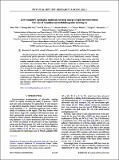Por favor, use este identificador para citar o enlazar a este item:
http://hdl.handle.net/10261/265300COMPARTIR / EXPORTAR:
 SHARE SHARE
 CORE
BASE CORE
BASE
|
|
| Visualizar otros formatos: MARC | Dublin Core | RDF | ORE | MODS | METS | DIDL | DATACITE | |

| Título: | Low-symmetry topological materials for large charge-to-spin interconversion: The case of transition metal dichalcogenide monolayers |
Autor: | Vila, Marc CSIC ORCID; Hsu, Chuang-Han; Garcia, Jose H. CSIC ORCID; Benítez, L. Antonio CSIC ORCID; Waintal, X.; Valenzuela, Sergio O. CSIC ORCID; Pereira, Vitor M.; Roche, Stephan CSIC ORCID | Palabras clave: | Spin hall effect Topological materials Transition metal dichalcogenides |
Fecha de publicación: | 30-dic-2021 | Editor: | American Physical Society | Citación: | Physical Review Research 3(4): 043230 (2021) | Resumen: | The spin polarization induced by the spin Hall effect (SHE) in thin films typically points out of the plane. This is rooted on the specific symmetries of traditionally studied systems, not in a fundamental constraint. Recently, experiments on few-layer MoTe2 and WTe2 showed that the reduced symmetry of these strong spin-orbit coupling materials enables a new form of canted spin Hall effect, characterized by concurrent in-plane and out-of-plane spin polarizations. Here, through quantum transport calculations on realistic device geometries, including disorder, we predict a very large gate-tunable SHE figure of merit λsθxy≈1-50 nm in MoTe2 and WTe2 monolayers that significantly exceeds values of conventional SHE materials. This stems from a concurrent long spin diffusion length (λs) and charge-to-spin interconversion efficiency as large as θxy≈80%, originating from momentum-invariant (persistent) spin textures together with large spin Berry curvature along the Fermi contour, respectively. Generalization to other materials and specific guidelines for unambiguous experimental confirmation are proposed, paving the way toward exploiting such phenomena in spintronic devices. These findings vividly emphasize how crystal symmetry and electronic topology can govern the intrinsic SHE and spin relaxation, and how they may be exploited to broaden the range and efficiency of spintronic materials and functionalities. | Versión del editor: | http://doi.org/10.1103/PhysRevResearch.3.043230 | URI: | http://hdl.handle.net/10261/265300 | DOI: | 10.1103/PhysRevResearch.3.043230 | Identificadores: | doi: 10.1103/PhysRevResearch.3.043230 issn: 2643-1564 |
| Aparece en las colecciones: | (CIN2) Artículos |
Ficheros en este ítem:
| Fichero | Descripción | Tamaño | Formato | |
|---|---|---|---|---|
| Low-symmetry_topological_materials_dichalcogenide_monolayers.pdf | 750,89 kB | Adobe PDF |  Visualizar/Abrir |
CORE Recommender
SCOPUSTM
Citations
12
checked on 28-abr-2024
WEB OF SCIENCETM
Citations
10
checked on 24-feb-2024
Page view(s)
23
checked on 03-may-2024
Download(s)
47
checked on 03-may-2024
Google ScholarTM
Check
Altmetric
Altmetric
Este item está licenciado bajo una Licencia Creative Commons

